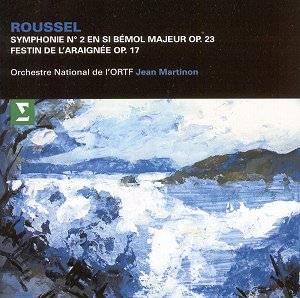Roussel's
music occupies a prominent place in the Erato catalogue. These
recordings are old and much-reissued ‘friends’ although this version
of the Symphony is perhaps less familiar having been rather supplanted
when, in the early 1980s, Erato recorded all four Roussel symphonies
with Charles Dutoit.
This
disc, and a series of others at bargain price, have been issued
as a celebration of the years since the founding of the Erato
Disques company in 1953.
The
two works offer a strong contrast. The years between were occupied
by a devastating war conducted on French soil and at hugely momentous
cost. Roussel found himself at odds with the impressionistic music
he had written before 1914 and adopted a more objective style.
Roussel the pupil of D'Indy and the admirer of Debussy is evident
in the Festin. The Symphony No. 2 however marks
a strong move away from the ecstatic nature-romance of the First
Symphony with all its redolence of d'Indy, Dukas and early Schmitt.
Roussel is now more in touch with de Falla although steering well
clear of the whirlpool of neo-classicism. Here he pitches towards
the modernism of the times from Mossolov, Bartók and Markevitch.
This major piece is not the work of a composer eager to please.
His stance is subdued and fearful (listen to the Breughel visions
suggested at 2.53 in the final third movement). Roussel spoke
of this music describing the trajectory of a life - 1. the joyful
illusions of youth; 2. profound impressions of maturity; 3. the
pain, bitterness and final peace when death separates us from
life's passions. The Symphony ends in the most impressively sustained
calm - as does the Festin ballet.
Notewriter
François Laurent mentions Jean Martinon as a kindred spirit
of Roussel's and that the philosophical schema of the Second Symphony
is also reflected in Martinon's own Fourth Symphony, Altitudes.
In addition I would add that there are parallels in the four symphonies
of Marcel Landowski once recorded on Erato as part of a complete
Landowski Edition.
Festin
de L'Araignée (The Spider's Banquet)
ballet was written in three months at the commission of Jacques
Rouché to a scenario by Gilbert de Voisins. It was premiered
on 3 April 1913 under the conductor-composer-arranger Gabriel
Grovlez. This is a work in which Roussel's romantic exemplars
(D'Indy and Dukas) meet Debussy and Ravel - the ecstatic impressionists.
The work has much the same tender, reflective, delicate, lively
qualities and harmonic flavour as Ravel's Ma Mère l'Oye
and Daphnis et Chloé. The funeral march at 29.07
is done with delicate yet ponderous tread - magically handled
by Martinon with a sense of vulnerable wonder. This is a work
not as consistently enchanted and enchanting as Ma Mère
l'Oye but sure to please that work's many admirers.
The
story of Festin is set in a garden and is concerned with
the insect life - its tragedies and joys. A butterfly caught in
the spider's web dies and is carried off by the arachnid. A fallen
apple startles the spider. Worms and mantises fight over the fruity
prize. A passing mayfly, having enjoyed its transient heyday,
falls to its death. The spider is ready to tuck in to the butterfly
corpse but is killed by one of the mantises. The insects give
a funeral to the mayfly then gradually disperse as night falls
in the garden.
The
recording of Festin is exceptionally clear yet resonant
- the best of the Martinon-Roussels reissued by Erato. There is
some passing distortion (at 8.17 in the first movement of the
Symphony) completely absent from the companion Roussel disc (Aeneas
and Bacchus - also reviewed here).
It
is a pity again, exactly as happened with the other Roussel disc
(Aeneas and Bacchus), that Warners have not separately
banded the episodes in the ballet. The disc is in five tracks:
one for each of the movements of the symphony and a single half
hour track for the ballet.
The
notes by François Laurent are succinct and there is an
admirably fluent translation into English by Adrian Shaw.
Momentary
distortion aside these are faithful and enjoyable recordings and
offer the wary newcomer to Roussel a chance to try music that
always seems to occupy the periphery. This selection has the attraction
of showcasing Roussel the nature impressionist as well as Roussel's
new objectivity.
Rob
Barnett
